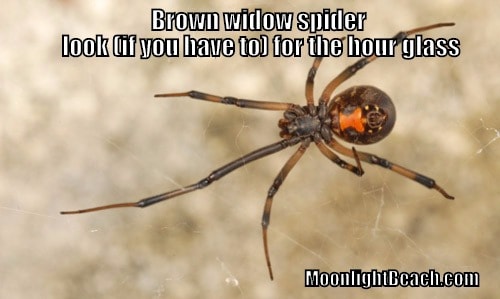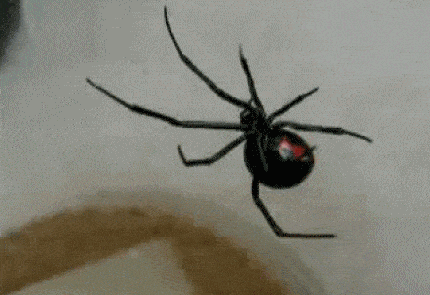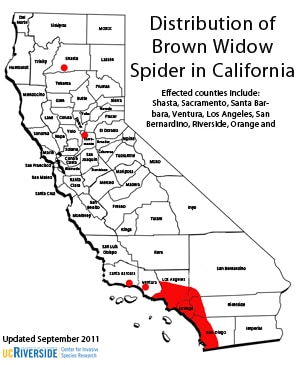You Have Some New Neighbors That You Haven’t Met Yet.
NBCSanDiego.com reports, “The population of brown widow spiders has been growing in San Diego County over the past decade, and experts are warning residents to be cautious.”
Be Cautious About Spiders – This Means You
This is how one your neighbors looks.
Not to be outdone, here is a black widow spider… in action. Note the hour glass as well.
If You Really Have To Know
The brown widow (aka Latrodectus geometricus) is slightly smaller and generally lighter in color than the black widow species (Latrodectus mactans). Brown spiders have color which can range from tan to dark brown to black, with shades of gray also possible. Like the black widow species in the United States, L. geometricus has a prominent hourglass-shaped marking on the underside of the abdomen; the brown widow’s hourglass, however, is usually a vivid orange or a yellowish color.
The species of spiders originally migrated from Africa to Southern California in 2005. Our climate is favorable for them and brown spiders have become very common.
An informational video from the County of San Diego on how to tell the black widow and brown spider apart.
And, one more video, just to scare you.
For those of you who love horror flicks…
Brown And Black Spiders Hiding Places
In short, they hide where you live. The spiders can be found in yards, under piles of wood, in sheds and anyplace outside that provides them with a bit of cover. Be sure to check your boots or shoes if you keep them outside.
In this video, it takes 45 seconds for the black widow to come out of the shoe
Bites: Some Difference, But Not Much
Brown widow spider bites can cause pain and redness, headache, nausea and muscle spasms. Black widow spider bites typically cause the same symptoms but often result in more pain. A good rule of thumb is to treat brown spiders as you would a bit from a black widow.
When In Doubt, Check It Out
Most people aren’t going to be sure which spider bit them, so seek medical treatment promptly.
A bit of good news… brown widow spider bites are extremely rare.
So… Just Where Do These Little Brown Spider Critters Live?
Glad you asked. They live near you. These two graphic are courtesy of the UC Riverside Dept. of Entomology
This information – Brown Widows: What you Need to Know – is from the County of San Diego. They actually took the time to create this report, so you know it can be an issue for local residents. “You should treat them the same way you treat black widows,” said Chris Conlan, supervising vector ecologist from the County Department of Environmental Health (DEH).
County of San Diego Information On Brown Spiders
How to Identify Them: A lot of people may not be able to easily pick out a brown widow from any other brown spider. Females can be up to ½ inch in length with legs extended. Males are much smaller. Like the black widow, which has a red, distinctive hourglass marking on its underside, the brown widow also has an hourglass-like marking on its abdomen; but it’s orange in color. The easiest way to tell if you have brown widows is by finding their egg sacs, which are very different than other spiders. They are spherical in shape. But instead of being smooth, they’re covered in tiny spikes.
Where Brown Spiders Come From: Conlan said that there is still some debate about this, but that most believe the brown widow originated in South Africa.
“Part of the reason for the debate is that the brown widow is such a good hitchhiker that it went worldwide before scientists had the chance to study the critter,” Conlan said.
Are Brown Widows Pushing Black Widows Out of the State? Conlan said that is difficult to say. Even though brown widow populations have jumped, he said, they’re still being found mainly in urbanized areas. Conlan said until more are found in rural areas outside of those urban settings, it will be difficult to tell if the invasive brown widow is out-competing — and driving out — native black widow spiders.
The Brown Widow in Southern California
This description is from the UC Riverside Dept. of Entomology, “In February of 2003, specimens of the non-native brown widow spider, Latrodectus geometricus, were discovered as part of the Los Angeles Spider Survey being conducted by the Los Angeles County Museum of Natural History. This was an interesting discovery and one that is mostly of scientific interest to southern California arachnologists. However, the ensuing media attention that was given to the spider has created the false impression that the brown widow is a new danger in southern California. Reports have correctly stated that the spider’s venom is fairly potent but because the spider injects so little, it is not of major consequence. Yet one hyperbolic report stated that the spider hasn’t killed anyone so far. This is not surprising because the brown widow is not a dangerous nor deadly spider. Even though it has venom of high toxicity, this is typically determined with injections of venom into mice or rabbits and conclusions from this are inferred with little real-world relevance. Much more relevant is the effects of actual spider bites. A South African medical journal reports on the bites of 15 brown widows in humans (Muller 1993) . Only two symptoms of brown widow envenomation were reported in the majority of bite victims: 1) pain while being bitten and 2) a mark where the bite occurred. That’s it. Not much more. The bite of the brown widow is about the same as any non-poisonous spider. It hurts and leaves a little mark on the skin. It is no big deal. There are none of the serious, protracted symptoms that one would exhibit when bitten by a black widow. So even though the non-native brown widow is virtually harmless, it is getting all this publicity and people are concerned about it. The hyperbolic response of the media and the general public to this new resident of southern California is ludicrous considering there are millions (maybe billions) of native black widows, Latrodectus hesperus, all over southern California, which have a far more poisonous venom than the brown widow, poses a much greater potential danger due to its great numbers and venom toxicity than the brown widow could ever hope to pose, black widow bites do occasionally happen, no one dies, people see black widows all the time, kill them and are not particularly concerned about them. Yet you don’t see media articles about the black widow because it isn’t “news”. The brown widow is not a spider of medical concern and is not likely to become one. It isn’t dangerous where it currently lives and there is no reason to believe that all of a sudden it will become dangerous now that it is in southern California. The native black widow is still the major spider of potential medical importance in southern California, always has been and always will be here. Reference: Müller, G. J. 1993. Black and brown widow spider bites in South Africa. South African Med J. 83:399-405.”
Well, you ask, are there any more spiders to consider…
The Brown Recluse Spider
This description is from the UC Riverside Dept. of Entomology, who probably know this better than almost anyone, “Description of the Brown Widow: Unlike its starkly black-and-red colored relative, the black widow, the coloration of a brown widow consists of a mottling of tan and brown with black accent marking. In mature females, there is usually a dorsal longitudinal abdominal stripe and three diagonal stripes on each flank. At the top of each diagonal stripe, there is a black mark, which is rather conspicuous and square-ish. The Brown Widow Spider does have an hourglass but it is typically an orange shade rather than the vivid red of a black widow. The brown widow looks similar to immatures of the western black widow spider, the latter of which has smaller black spots on the top of the diagonal abdominal stripes and more olive grey background coloration. Being able to discern brown widows from immature black widows is therefore difficult and requires some experience. However, a more diagnostic feature of a brown widow is its egg sac. Most spider egg sacs that are free (i.e., are not attached to flat surfaces) look like a lemon drop candy or a little cotton ball with indistinct edges. The egg sac of a brown widow has multiple silk spicules projecting out from the surface. The egg sac has been described as looking like a large pollen grain or a World War II harbor mine designed to blow up ships. The egg sac of the Brown Widow Spider is so distinctive that it is readily recognizable.”



